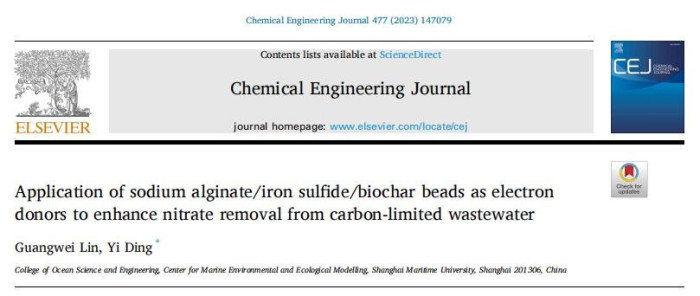Recently, Lin Guangwei, a grade-20 graduate student in Transportation Safety and Environmental Engineering, College of Ocean Science and Engineering, published a paper titled Application of sodium alginate/iron in Chemical Engineering Journal, a top international journal in the field of engineering technology and chemical engineering sulfide/biochar beads as electron donors to enhance nitrate removal from carbon-limited wastewater (Study on the enhancement of nitrate removal from low-carbon wastewater by using a sulfur-iron carbon electron donor matrix). Associate Professor Ding Yi from the Department of Marine Environment, as the corresponding author of this paper, participated in the guidance of this innovative research throughout the whole process.
Coastal waters are a crucial component of the global Marine ecosystem. This study focuses on the treatment of eutrophication in coastal waters, aiming to improve the removal efficiency of nitrate nitrogen in low-carbon water by developing an economical and efficient electronic donor composite matrix, and provide a new idea and method for the restoration and utilization of seawater resources in China. In this study, sodium alginate (SA), biochar (BC) and nano-iron sulfide (n-FeS) were selected as raw materials to prepare electron donor composite matrix, which has porous through and three-dimensional interlaced fibrous structure, which is conducive to microbial habitat growth and pollutant adsorption and degradation. In addition, the material can provide organic and inorganic electron donors for the microbial denitrification process, forming an autotrophic-heterotrophic collaborative denitrification system, effectively improving the electron shuttle, transfer and utilization efficiency, the removal rate of nitrate nitrogen in the water body can reach more than 98%, and the water quality is stable and safe. Ms. Ding Yi and her research team have been closely focusing on the development direction of the department's ship and sea characteristics, and have carried out organized scientific research work together with the scientific research team of the Department of Marine Environment, focusing on key issues in key areas of Marine and maritime affairs, realizing three-dimensional monitoring and efficient restoration of the Marine environment through ecological economy, green and safe technology methods, and focusing on originality, innovation, leadership and application of research work. In this process, we should actively do a good job in the professional and comprehensive ability training of postgraduates, and cultivate high-quality talents for the professional, industrial and national scientific and technological innovation and development.
Chemical Engineering Journal is one of the most influential journals in the field of engineering technology and chemical engineering, aiming to report the technological methods and research results of significant innovation and practical significance in the aspects of new discoveries in chemical engineering and new progress in the application of materials synthesis. It is the top journal in the Engineering Technology/Chemistry/Environment Region 1 in the Chinese Academy of Sciences sub-region, with the latest impact factor of the journal reaching 15.1 in 2022-2023.

Figure 1 Paper publication information

Figure 2 Presentation of paper results
